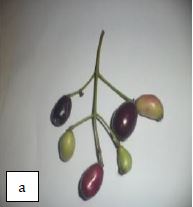Testing methods of moisture content, critical moisture content, and germination of jamblang (Syzygium cumini (L.) Skeels) seed

Jamblang (Syzygium cumini (L.) Skeels) researches are still focused to identify the plant benefits, but that leads to efforts to obtain good seed quality hasn’t been done. This study aims to determine the moisture content testing method, the critical moisture content, and germination testing method (sowing media and first and final count of seed germination). Improving procedure for moisture content testing and identified the best media for germination testing was arranged in a Completely Random Design. Determining jamblang seeds critical moisture content was arranged in a Randomized Complete Block Design. The experiments were repeated four times. Moisture content with slicing method obtained 49.57%. Jamblang seeds critical water content is 41.61% with 50% germination. The best method of germination was sand medium with fresh seeds (90%). The first count of jamblang seed germination occurs on 32 days after sowing and final count on 83 days after sowing.
Afify, A. E. M. M., El-Beltagi, H.S., Fayed, S.A., & Shalaby, E.A. (2011). Acaricidal activity of different extracts from Syzygium cumini L. Skeels (Pomposia) against Tetranychus urticae Koch. Asian Pacific Journal of Tropical Biomedicine, 1(5), 359–364.
Aminah A., & Dida, S. (2013). Penentuan karakteritik fisiologis benih kranji (Pongamia pinnata) berdasarkan nilai kadar air. Jurnal Penelitian Hutan Tanaman, 10(1), 1-6.
Ayyanar, M., & Subash-Babu, P. (2012). Syzygium cumini (L.) Skeels: A review of its phytochemical constituents and traditional uses. Asian Pacific Journal of Tropical Biomedicine, 2(3), 240–246.
[BBPPMBTPH] Balai Besar Pengembangan Pengujian Tanaman Pangan dan Hortikultura. (2011). Pengujian Mutu Benih Tanaman Pangan dan Hortikultura. Depok.
Devi, C. A., Swamy, G. S. K., & Naik, N. (2016). Studies on Storage and Viability of Jamun Seeds (Syzygium cumini Skeels). Biosci Biotech Res Asia, 13(4), 2371–2378.
Eliya, S. & Nurhasybi. (2014). Pengujian viabilitas benih weru (Albizia procera Benth). Jurnal Perbenihan Tanaman Hutan, 2(1),12-23.
Fatema, F., Khan, Z. H., Khan, N. D., & Mular, S. M. (2017). Determination of amylase activity from germinated Syzygium cumini seed (jamun). International Journal of Applied Research, 3(1), 573–575.
[ISTA] International Seed Testing Association. (2014). International Rules for seed testing, edition 2014. Switzerland: International Seed Testing Association.
Kumar, A., Ilavarasan, R., Jayachandran, T., Deecaraman, M., Kumar, R. M., Aravindan, P., … Krishan, M. R. V. (2008). Anti-inflammatory activity of Syzygium cumini seed. African Journal of Biotechnology, 7(8), 941–943.
Masetto, T. E., Marques, E., Paula, S. De, & Scalon, Q. (2014). Drying, storage and osmotic conditioning of Psidium guineense Swartz seeds. American Journal of Plant Sciences, 5(17), 2591–2598.
Purwaning, D. (2009). Struktur benih dan dormansi pada benih panggal buaya (Zanthoxylum rhetsa ( Roxb.). JMHT, 15(2), 66–74.
Rix, K. D., Alistair, J.G., Bradley, M. P., Philip, H. B., Peter, L. G. (2015). Genetic control of Eucalyptus Globulus seed germination. Annals of Forest Science, 72(4), 457-467.
Robert EH. (1972). Storage environment and the control of viability In: Robert EH (ed) Viability of Seeds. Chapman and Hail, Londo, pp. 14-58.
Sadjad S. (1994). Kuantifikasi Metabolisme Benih. Jakarta (ID): Grasindo.
Sadjad, S. (1993). Dari Benih Kepada Benih. Jakarta (ID): PT Grasindo.
Sukarman & Rusmin, D. (2000). Penanganan Benih Rekalsitran. Bulletin Plasma Nutfah, 6(1), 7-15.
Sumampow DMF. (2010). Viabilitas benih kakao (Theobroma cacao L.) pada media simpan sebuk gergaji. Soil Environment, 8(3), 102-105.
Tresniawati, C., Murniati, E., & Widajati, E. (2014). Perubahan fisik, fisiologi dan biokimia selama pemasakan benih dan studi rekalsitransi benih kemiri sunan. JAI, 42(1), 74–79.
Yuniarti, N., & Leksono, B. (2013). Teknik perlakuan pendahuluan dan metode perkecambahan untuk mempertahankan viabilitas benih Acacia crassicarpa. Jurnal Penelitian Kehutanan Wallacea, 2(1), 1–11.

